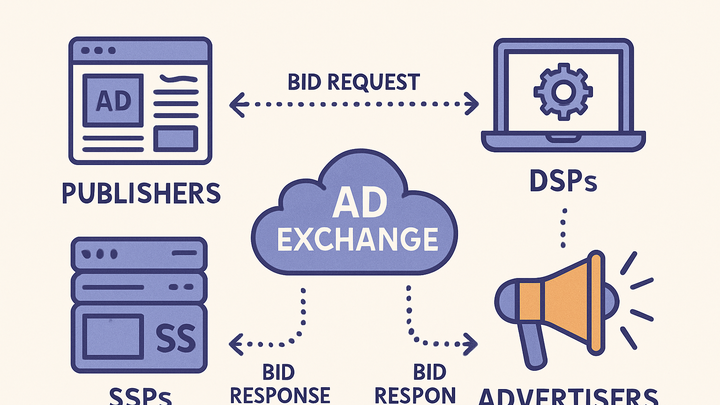Published on 2025-06-28T05:34:02Z
What is an Ad Exchange? Examples in Analytics
An ad exchange is a digital platform that facilitates the automated buying and selling of advertising inventory between publishers and advertisers. It operates in real time, matching supply and demand through auction-based mechanisms known as real-time bidding (RTB). By connecting supply-side platforms (SSPs) that represent publishers with demand-side platforms (DSPs) used by advertisers, ad exchanges streamline transactions and maximize revenue opportunities. They also enforce quality controls, brand safety, and fraud detection to protect all parties involved. In analytics, data from ad exchanges informs insights on fill rates, bid landscapes, impression performance, and campaign ROI, empowering marketers to optimize ad spend and publishers to improve yield. Ad exchanges are a cornerstone of programmatic advertising, driving efficiency, transparency, and scalability across the digital ad ecosystem.
Ad exchanges
Ad exchanges are digital marketplaces that automate buying and selling of ad space via real-time bidding.
Overview of Ad Exchanges
This section provides a foundational understanding of what ad exchanges are and why they are central to programmatic advertising.
-
What is an ad exchange?
A digital marketplace that automates the buying and selling of advertising inventory in real time through auction-based mechanisms.
-
Key participants
Ad exchanges connect various stakeholders to facilitate transactions between supply and demand in the ad ecosystem.
-
Demand-side platform (dsp)
A system or platform that advertisers use to purchase ad impressions across multiple ad exchanges and supply sources.
-
Supply-side platform (ssp)
A platform that publishers use to manage and sell their ad inventory programmatically to multiple buyers.
-
Real-Time Bidding (RTB) Mechanism
Real-time bidding is the core process enabling ad exchanges to match inventory and bids in milliseconds.
-
Auction process
When a page loads, an ad impression is auctioned off instantly to the highest bidder in the exchange.
-
Open auction
All buyers registered in the exchange can submit bids, maximizing competition.
-
Private auction
Selected buyers are invited to bid, often with pre-negotiated floors for higher CPMs.
-
-
Bid request & response
Bid requests contain impression data and user signals; responses include bid values and creative assets.
Integration with Analytics Tools
Collecting and analyzing ad exchange data through analytics platforms enables performance tracking and optimization.
-
PlainSignal implementation
PlainSignal offers a privacy-focused, cookie-free analytics solution that can capture ad exchange metrics seamlessly.
-
Tracking code example
<link rel="preconnect" href="//eu.plainsignal.com/" crossorigin /> <script defer data-do="yourwebsitedomain.com" data-id="0GQV1xmtzQQ" data-api="//eu.plainsignal.com" src="//cdn.plainsignal.com/plainsignal-min.js"></script>
-
-
Google analytics 4 (GA4)
GA4 can ingest ad exchange metrics via server-side tagging or BigQuery exports for deeper analysis.
-
Basic GA4 tag
gtag('config', 'GA_MEASUREMENT_ID');
-
Benefits and Challenges
Ad exchanges offer significant advantages but also come with considerations for both publishers and advertisers.
-
Benefits
Key advantages of using ad exchanges in programmatic advertising.
-
Efficiency
Automates the ad transaction process, reducing manual work and accelerating campaign deployment.
-
Transparency
Provides clear insights into bid dynamics, pricing, and performance metrics.
-
Scale
Grants access to a broad range of publishers and audiences across multiple exchanges.
-
Performance optimization
Enables real-time adjustments to bids and targeting based on data-driven insights.
-
-
Challenges
Common obstacles and risks associated with ad exchanges.
-
Complexity
Programmatic setups require technical expertise and ongoing optimization efforts.
-
Privacy concerns
Evolving regulations and the decline of third-party cookies demand alternative targeting methods.
-
Ad fraud
Susceptibility to non-human traffic and fraudulent practices can affect ROI without proper safeguards.
-
Auction dynamics
Bid landscapes can vary greatly, resulting in unpredictable CPMs and fill rates.
-
